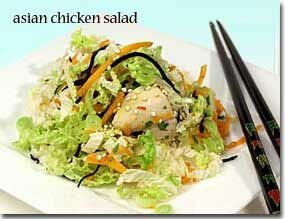healthy food tip and recipe
Today's Recipe
If you don't know what to serve for dinner tonight ...
Avoid dry chicken breasts by using our Quick Broil cooking method — it's a great way to retain the moisture and flavor of chicken when you want to include it as part of your Healthiest Way of Eating. Enjoy this tasty recipe and the health benefits that come from it's wealth of health-promoting nutrients.

Ingredients:
- 2 boneless chicken breasts, skin on
- 5 cups Chinese cabbage, sliced thin
- 1/2 cup shredded carrot
- 1/2 cup minced scallion
- 1/2 cup sliced almonds
- 1/4 cup chopped fresh cilantro
- 2 TBS toasted sesame seeds
- Optional: 2 TBS dried hijiki or arame seaweed, soaked in 1 cup warm water and chopped*
- Dressing
- 2 TBS extra olive oil
- 2 TBS soy sauce
- 1/4 cup rice vinegar
- 3 TBS honey
- pinch red pepper flakes
- salt & white pepper to taste
- *The safety factors regarding sea vegetables, such as hijiki
- Preheat broiler. Place a stainless steel (be sure the handle is also stainless steel) or cast iron skillet in the broiler, about 7 inches from the heat source, to get it very hot. Season chicken with a little salt and pepper.
- If you are using hijiki or arame place it in a small bowl of hot water to soften for about 10 minutes.
- While pan is heating, thinly slice cabbage, and shred carrot. Carrot is easily shredded in food processor with shredding blade. Otherwise you can shred it by hand, or slice it thin. Chop cilantro and scallion cabbage and carrot mixture. Add sliced almonds. Squeeze excess water from hijiki, chop if needed, and add to salad.
- When pan is hot, about 10 minutes, remove from broiler, and place chicken in pan, skin side up, and return to broiler. Cook for about 15 minutes depending on thickness of chicken. This is our Quick Broil cooking method. When done and cool enough to touch, remove skin, and cut into bite-size pieces.
- Whisk together olive oil, soy sauce, rice vinegar, honey, red pepper flakes, salt, and pepper. Toss with cabbage mixture and chicken. Sprinkle with sesame seeds. (You can buy sesame seeds that are already toasted.)
In-Depth Nutritional Profile for Asian Chicken Salad
Healthy Food Tip
What can you tell me about food cravings in general and more specifically about my cravings for peanuts?
I believe that a person's body is always trying to stay optimally healthy and to heal from injury or illness. Therefore, I believe that your body might be trying to tell you something through your cravings. Exactly what it's trying to tell you, however, is difficult to determine.
In a nutritional sense, cravings can sometimes be related to nutrients that are most needed by the body. Peanuts, for example, are a good source of manganese, niacin, folate, copper, and protein. Peanuts also contain some resveratrol, the phytonutrient that's become so famous in red wine. Peanuts are not unusually rich in this nutrient--an ounce of peanuts contains about 50 micrograms of resveratrol at most, compared to nearly 1,000 micrograms in an ounce of red wine. However, over the course of time, if peanuts are enjoyed on a daily basis, they could be a worthwhile source of this resveratrol.
Cravings can also be related to food allergies, and it is possible for a person to crave a food to which they are most allergic. (Although this may seem contradictory, craving a food to which we are allergic is a fairly common occurrence in nutrition, and one that is documented in scientific research.) In the allergy research literature, peanuts turn out to be a very common allergenic food.
So how can you tell if your personal craving for peanuts is based on the helpful nutrients that peanuts are providing or if it's the result of an unwanted allergic reaction? You may not be able to make this decision without the help of an experienced healthcare practitioner. If you have never worked with a nutritionist or other healthcare provider who is familiar with food allergies and elimination/challenge diets, I would encourage you to consider taking that step.
Of course, meeting your nutrient needs or getting caught up in a potentially adverse food reaction may not be the only reason you might be craving peanuts. Peanuts might be an unusually enjoyable food for you based on your past food habits. Or perhaps, they are a "comfort food" that is reassuring to eat. While pleasure and comfort certainly aren't reasons to avoid peanuts, feeling in control of your Healthiest Way of Eating is always an important aspect of nourishment.

No comments:
Post a Comment